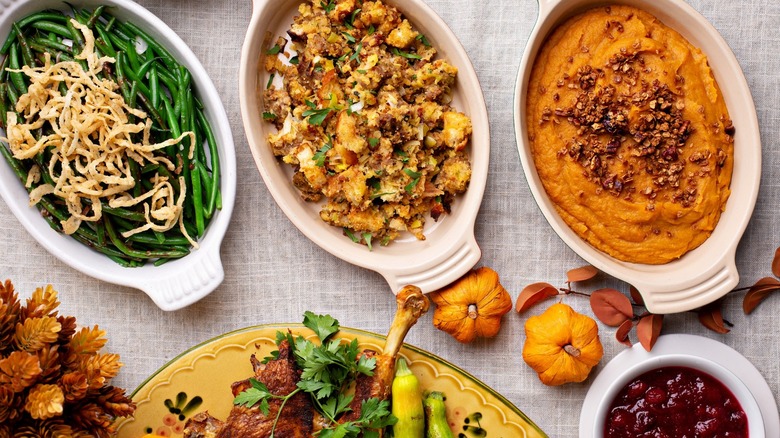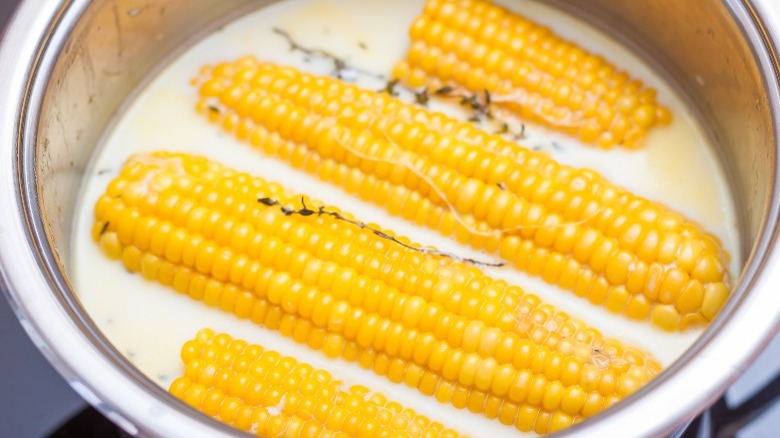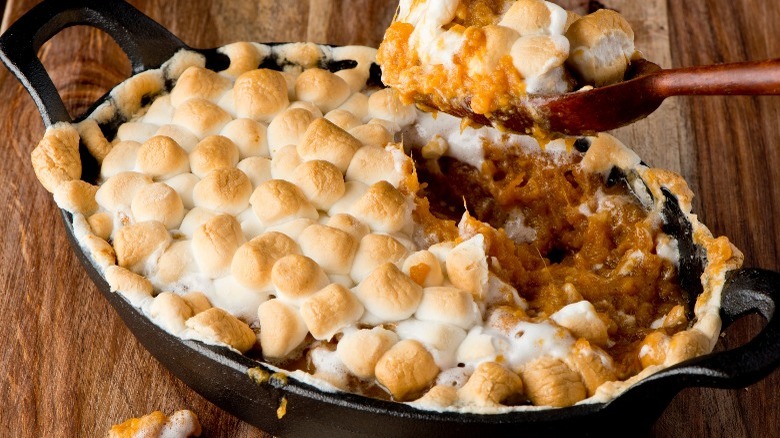The Lush Way To Enhance Your Thanksgiving Sweet Potatoes
In the last decade or so, we've all learned the true beauty and nutritional value of eating sweet potatoes all year long. Like kale and avocados, sweet potatoes (sometimes erroneously referred to as yams here in the U.S.) have found a trendy niche among health-conscious foodies, vegetarians, and vegans alike. Full of vitamins A, B, and C, beta-carotene, antioxidants, and minerals like potassium and manganese, all varieties of sweet potatoes have a lower glycemic index than their potato counterparts (via Healthline). While tasty recipes range from Hasselback Sweet Potatoes to homemade potato chips to Spiced Sweet Potato Bread, and a myriad of casseroles and salads, around this time of year sweet potatoes really get their chance to shine in dishes like candied "yams" and sweet potato pie.
But as good as those dishes are, is there a way to level them up? According to Kitchn, there sure is. And while it's been newly dubbed "butter bath," the cooking technique itself has actually been around for a long time and is an excellent way to infuse even more flavor into your holiday feast, while still getting the most bang for your buck nutritionally.
What is a butter bath?
Most simply put, a butter bath is cooking your food in a good quantity of butter and other liquids or seasonings to infuse it more deeply with flavor. Sometimes the butter is paired with milk and water, as Taste of Home notes they do in the South when cooking ears of corn. And while the term used is often "boiled," any careful recipe reader will recognize that what's actually being done is simmering. Although Taste of Home advises readers to bring their liquid to a boil, the flame is reduced before the food is placed inside.
Cooking Light describes the difference between boiling and simmering as a spectrum, explaining that bubbles in boiling water are in "full motion," rising and breaking on the surface of the water, while there should be little to no bubbles in simmering. While the water will be in motion, you'll rarely see a bubble break the surface because simmering happens just below the boiling point. This makes all the difference when trying to infuse flavors. While boiling is great for cooking pasta or greens and to harness the evaporative power to concentrate sauces, simmering is gentler and slower, infusing food with the fats, liquids and flavors it's bathed in.
How to butter bathe your holiday sweet potatoes
Used with a variety of foods like chef Derek Wolf's butter-bathed steaks and shrimp boils (via Food Network), the technique of simmering foods in a "butter bath" is popular for good reason — it makes everything taste delicious. Whichever foods you choose to butter bathe, the technique is the same: Bring your butter, herbs, spices, and other cooking liquids (such as milk, water, or stock) to boil, lower the heat, add the item, and let it simmer until done for truly penetrating flavor. But how can a butter bath make your holiday sweet potatoes sing? As in Wolf's steak recipe, the butter bath helps intensify the seasonal flavors by cooking them into the food at hand — whether it is steak, sweet potatoes, or something else.
According to Kitchn, no matter how you like your sweet potatoes — whether casseroled and topped with mini-marshmallows, tossed in a chunky stew, pureed in a pie, or topped with candied pecans — a butter bath can take your favorite recipe to the next level. Butter bath sweet potatoes in water, milk, butter, and cinnamon like Kitchn or swap cinnamon for pumpkin pie spice before adding them to your new souped up sweet potato pie. Add sweet tater chunks bathed in lush butter and broth seasoned with thyme, sage, marjoram, and rosemary to your famous turkey-day-leftovers soup, or butter bathe them in ginger, orange juice, allspice, and zest before whipping them into grandma's sweet potato orange cups.
The possibilities are endless, as will the be the thanks you get for a holiday feast well done.


